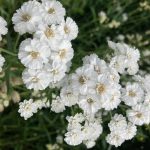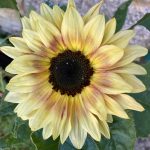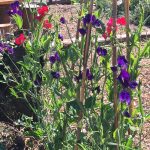How to grow... Cut Flowers
Rocket Growing Guides

The following growing advice assumes that you will be growing your cut flowers in blocks in a dedicated raised bed (or similar) so that you can harvest them for cutting.
If you would prefer to simply pot on the plugs and then plant them out into mixed flower beds and borders when they are bigger, then you will need to give the flowers a little more space for growing (add on approx 10cm spacing) and remember to plant taller flowers at the back of borders.
Pots and containers are less suitable for growing flowers for cutting, but can be done. If this is your preferred option, then we’d recommend choosing large pots if possible so that you can fit more in. Rectangular/square planters are great or try an old wheelbarrow.
- Cut Flowers Growing Guide
How to Plant Cut Flowers
- You can plant our cut flower plug plants anytime from late April to July. Plant out after all risk of frost has passed.
- They will do best in a position where they get maximum sunlight and are well sheltered from the wind.
- We’d recommend choosing a dedicated patch of bare soil in the garden, however you can also plant them in amongst your veggies (great for pollinators!) or other flower beds and borders if you prefer. The downside of the latter is that you may not wish to cut them if they form part of the aesthetic of your garden!
- Pots and containers are less suitable for growing flowers for cutting, but can be done. If this is your preferred option, then we’d recommend choosing large pots if possible so that you can fit more in. Rectangular/square planters are great or try an old wheelbarrow.
- Wherever you plant your cut flowers, be sure to dig in or spread plenty of organic compost to enrich the soil and improve soil consistency (particularly in clay soil)
- As a general rule, you can plant the plug plants in rows/blocks leaving 20cm spacing each way. The exception is sweet peas. Please see below for further information on growing each variety.
How to Care for Cut Flowers
- A wormcast or comfrey tea feed once or twice a month will really benefit your flowers. Simply mix a handful of wormcast into a full watering can and apply, or make a comfrey tea by soaking comfrey leaves in a bucket of water for 1-2 weeks.
- Regular watering, particularly while the plants are still young, is important. Best to water early morning so that the soil can dry out again before dusk to keep slugs to a minimum.
- It is best to give the plants some support. Do this at the point of planting. We’d recommend stretching some wide gauge netting between bamboo stakes driven in at the corners and edges of beds – position it so that the net sits horizontally, approximately 30cm above the seedlings.
- All our cut flowers are best treated as annuals, and can be cut back at the end of the season. However you can leave them to self-seed in autumn if you like
How to Harvest Cut Flowers
- The best time to cut flowers is early morning (or evening) – you may notice that if you cut them in the middle of the day they wilt much more in the vase.
- It’s best to cut just before/as the bud starts to open. Strip off the lower leaves as you pick (the leaves that would be below surface level once in the vase)
- Cut stems a little longer than you need for your vase, being sure to leave some side shoots on the plant and most will keep growing flowers for you throughout the summer.
- Have a bucket of water with you so that you can pop stems straight into water as you harvest your flowers. Put the bucket and flowers into a cool, shady spot for an hour or so until you are ready to put them into vases – this will give them a chance to draw up some water and recover from being cut!
- When it comes to arranging, and use a pair of secateurs to cut the stems at an angle so that they don’t sit flat on the base of vase – this’ll prolong their lifetime a little allowing them better access to water.
Growing Guide for different varieties
| Flower Name (Variety*) | Height (approx) | Spacing | Support Type | Harvest |
| Love-in-a-Mist (Persian Jewel) | 40cm | 20cm | Horizontal Net | Jun-Sep |
| Snapdragon (Crown Mix) | 45cm | 20cm | Horizontal Net | Jul-Sep |
| Cosmos (Sensation Mix) | 110cm | 30cm | Horizontal Net | Jul-Oct |
| Cornflower (Crown Double Mix) | 70cm | 20cm | Horizontal Net | Jul-Sep |
| Larkspur (Crown Blend) | 120cm | 20cm | Horizontal Net | Jul-Sep |
| Sweet Pea (mixed) | 150cm | 20cm | Wigwam/Trellis – 1.5m tall | Jul-Sep |
| Zinnia (Purple Prince) | 90cm | 30cm | Horizontal Net | Jul-Oct |
| Hare’s Ear (Griffiti) | 80cm | 20cm | Horizontal Net | Jul-Sep (foliage) |
| Bells of Ireland | 80cm | 30cm | Horizontal Net | Jul-Sep (foliage) |
| Honeywort (Cerinthe) | 60cm | 20cm | Horizontal Net | Jun-Oct |
| Achillea (Ptarmica Ballerina) | 40-50cm | 30-40cm | Horizontal Net | Jun-Sep |
| Achillea (Milefolium Cerise Queen) | 60cm | 30-40cm | Horizontal Net | Jun-Aug |
| Acroclinium (Grandiflorum Mixed) | 30cm | 20cm | Horizontal Net | Jul-Sep |
| Snapdragon (Lucky Lips) | 60cm | 25cm | Horizontal Net | Jun-Sep |
| Candytuft (Iberis Crown Mix) | 25cm | 40cm | Horizontal Net | May-Sep |
| Chrysanthemum (Crazy Daisy) | 80cm | 40cm | Horizontal Net | Jun-Oct |
| Cobea (Scandens Alba/Purple) | 3m | 30cm | Trellis/Wigwam | Jul-Oct |
| Dahlia (Figaro Improved) | 30-40cm | 20cm | Horizontal Net | Jul-Sep |
| Delphinium (Crown Mixed) | 140-160cm | 30cm | Horizontal Net | Jun-Sep |
| Didiscus Caerulea (Blue Lace) | 60cm | 30cm | Horizontal Net | Jul-Sep |
| Ipomoea (Morning Glory) | 60cm | 30cm | Treillis/Wigwam | Jun-Oct |
| Lupin (Gallery Mix) | 70cm | 30cm | Horizontal Net | May-Jul |
Types to try
-

Carnation – Orange Sherbert
More -

Aster – Ostrich Plume Mixed
More -

Acroclinium – Grandiflorum Mixed
More -

Achillea – Ptarmica Ballerina
More -

Chrysanthemum – Crazy Daisy
More -

Candytuft (Iberis) – Crown Mixed
More -

Cornflower – Crown Mix
More -

Helianthus Sunflower – Cucumerifolius Mixed
More -

Helianthus Sunflower – Summer Lovin’
More -

Dahlia – Figaro Improved
More -

Everlasting Sweet Pea – Lathyrus Latifolius Crown Special Mix
More -

Sweet Pea – Giant Spencer
More
